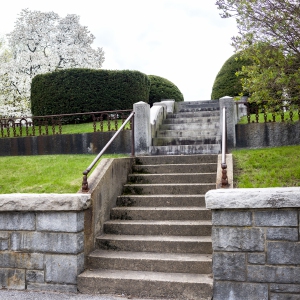Add a labyrinth garden to your yard
| Published: 05-10-2019 4:11 PM |
A labyrinth garden should not be puzzling – that’s a maze. A labyrinth and a maze were once the same, but the labyrinth has recently grown to become a totally different animal.
Enter a labyrinth and every turn you make is the correct one, leading you to the center. The labyrinth might be considered a metaphor for a spiritual quest, a path that is mindfully traveled. While a maze has you scratching your head and retreating from dead ends, the labyrinth brings tranquility. No confusion, no disorientation, no tricks, no unknowns.
A labyrinth does not have to be in a garden, or even outdoors, but what better place for a meditative walk with poised senses? The area need not be large, either. One of the best known labyrinths, on the floor in the cathedral at Chartres, France, is only 42 feet across, but the paths within it trace a distance of 850 feet. Twenty-five feet across is probably a minimum workable dimension for a labyrinth.
The design of a labyrinth is usually based on a series of concentric circles. For a simple design, put a barrier preventing further travel within the outer ring of concentric circles opposite the point of entry; but on either side of that barrier put entries into the next inner ring.
You can turn left or right upon entering this ring, just as you could when entering the outermost ring. This ring likewise has a barrier across from its entryway, with – again – new entryways on either side to enter the next inner ring ... and so on, until the center of the labyrinth is reached.
Many other designs are possible, of varying complexity and visual effect. (For some other designs and more information, see labyrinthsociety.org). What they all have in common is that every turn leads, eventually, to a focal point.
There’s room for simplicity or complexity in translating a labyrinth design from paper to the ground. For the simplest, least permanent approach, mow or rake clean a portion of your lawn and trace out the paths with flour or cornmeal. Dusting flour or cornmeal on the lawn and using a human compass in “drawing” is a fun project with a child. (One person is fixed in place, holding a string, and the other person, holding the other end of the string, can trace out circles to “draw” on the ground.)
For a slightly more permanent labyrinth, one that requires slightly more effort, let part of your lawn grow long, then mow out your labyrinth’s pathways.
Article continues after...
Yesterday's Most Read Articles
 New England College expands $10,000-per-year offer to Concord, Bishop Brady graduates
New England College expands $10,000-per-year offer to Concord, Bishop Brady graduates
 ‘There’s tradition up here’ – Morrill Farm approaches its centennial, celebrates evolution and growth
‘There’s tradition up here’ – Morrill Farm approaches its centennial, celebrates evolution and growth
 AROUND CONCORD: Your guide to free summer music
AROUND CONCORD: Your guide to free summer music
 ‘Life long friends’: Three women worked together to welcome visitors to East Concord
‘Life long friends’: Three women worked together to welcome visitors to East Concord
 New Hampshire home prices hit an all-time record high amid housing shortage
New Hampshire home prices hit an all-time record high amid housing shortage
 Truck collision on South Main Street in Concord diverts traffic
Truck collision on South Main Street in Concord diverts traffic
For a bolder labyrinth, get out your shovel for earth moving and/or planting. The grounding effect of a labyrinth is perhaps made more so if the paths are nestled slightly down into the ground or, alternatively, if the lines separating the paths are mounded up.
If the mounds have a gentle slope, the whole labyrinth might be blanketed in nothing more than lawn grass.
As a gardener, all sorts of plant possibilities enter my vision at this point. How about some ornamental grass between the paths? Something light and airy like blue grama grass or muhly grass comes to mind. Both are clumping grasses, so will not take over the paths, and both tolerate dry conditions, so would do fine on mounds.
Mounds are not a must; the paths can have their edges traced with plants rather than mounded earth. Low-growing plants with year-round interest include sedums, artemesias, thymes and lavender. No reason to rule out showy, flowering plants either. Picture swathes of daisies and alliums defining paths.
I would suggest avoiding plants requiring a high degree of maintenance, though. As you walk your labyrinth, you don’t want to be constantly distracted by plants needing pruning, watering and weeding.
]]>







 Hopkinton art gallery showcases “Creativity Beyond Convention”
Hopkinton art gallery showcases “Creativity Beyond Convention” Around Concord: Steps to nowhere – but it used to be somewhere
Around Concord: Steps to nowhere – but it used to be somewhere Around Concord: Refreshing recipes from Table Bakery
Around Concord: Refreshing recipes from Table Bakery
